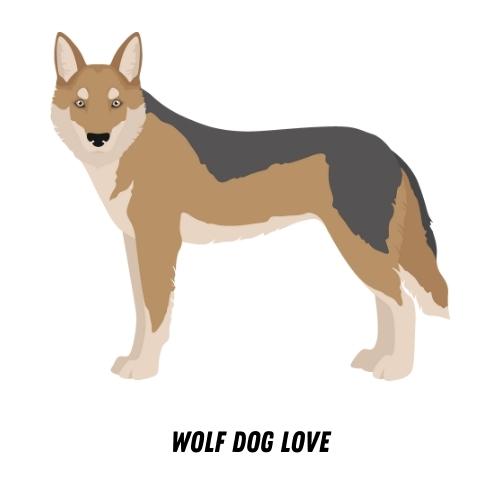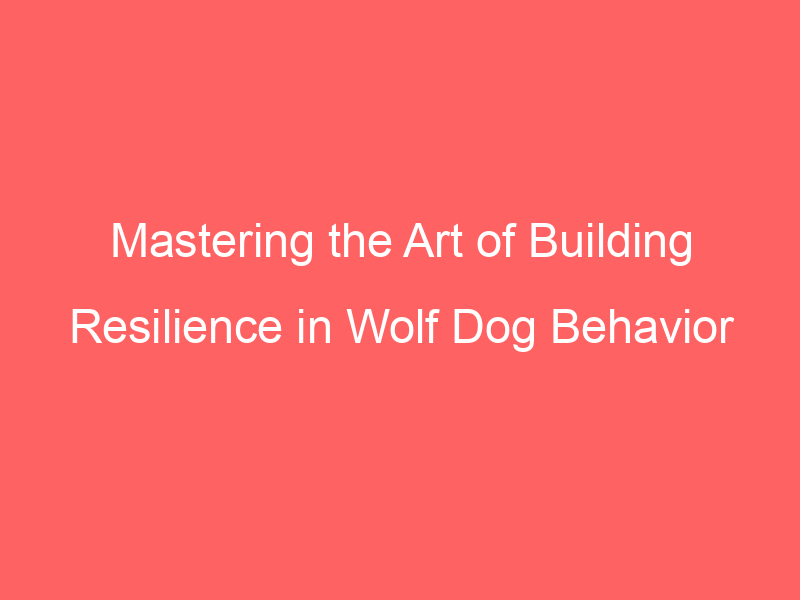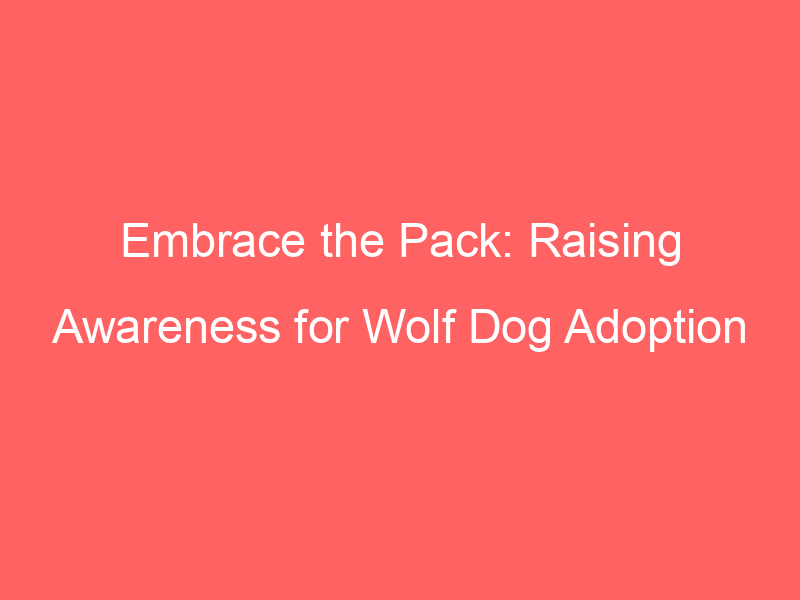Introduction to Wolf Dog Behavior
Wolf dogs are unique creatures that exhibit a blend of traits from both wolves and dogs. Understanding their behavior is crucial for any potential owner or animal enthusiast. This article will delve into the unique characteristics of wolf dog behavior and the importance of resilience in canine behavior.
- Understanding the Unique Characteristics of Wolf Dog Behavior
- Importance of Resilience in Canine Behavior
Wolf dogs are not your typical domestic dogs. They are a hybrid of a domestic dog and a wild wolf. This unique blend results in a set of behaviors that are a mix of both species. They are known for their high energy levels, intelligence, and independence. They also exhibit a strong pack mentality, which means they thrive in a family environment and can struggle with isolation. However, their wild instincts can also make them unpredictable and challenging to handle for inexperienced owners.
Resilience is a critical trait in canine behavior, especially for wolf dogs. It refers to a dog’s ability to adapt to new situations and recover from negative experiences. A resilient dog is more likely to handle changes in their environment, such as moving to a new home or the arrival of a new family member, with less stress. For wolf dogs, resilience can help them manage their wild instincts and adapt to living in a domestic environment. Building resilience in a wolf dog requires consistent training, socialization, and positive reinforcement.
Wolf Dog Training: Building Resilience
Training a wolf dog requires a unique approach, particularly when it comes to building resilience. Resilience in dogs refers to their ability to adapt to new situations, recover from adversity, and continue to thrive. This is especially important for wolf dogs, which have a combination of wild and domestic traits. Let’s explore the key principles of training resilient dogs and some specific techniques for wolf dogs.
-
Key Principles of Training Resilient Dogs
Training a resilient dog involves several key principles. These principles are applicable to all dogs, but they are particularly important when training a wolf dog.
- Consistency: Dogs learn best when training methods are consistent. This includes consistent commands, rewards, and consequences.
- Positive reinforcement: Rewarding good behavior is more effective than punishing bad behavior. This helps build a dog’s confidence and resilience.
- Socialization: Exposing a dog to a variety of situations, people, and other animals can help build resilience. This is particularly important for wolf dogs, which can be more wary of new situations than other dogs.
- Patience: Training takes time, and it’s important to be patient. This is especially true when training a wolf dog, which may take longer to learn new behaviors than other dogs.
-
Wolf Dog Resilience Techniques
When training a wolf dog, there are some specific techniques that can help build resilience. These techniques take into account the unique characteristics and behaviors of wolf dogs.
- Gradual exposure: Wolf dogs can be more sensitive to new situations than other dogs. Gradually exposing them to new experiences can help build their resilience.
- Building trust: Wolf dogs may be more wary of humans than other dogs. Building trust through consistent, positive interactions can help them feel more secure and resilient.
- Providing a safe space: Wolf dogs need a safe space where they can retreat if they feel overwhelmed. This can help them feel more secure and build their resilience.
- Using natural rewards: Wolf dogs may respond better to natural rewards, like the opportunity to explore a new area or play with a favorite toy. These rewards can be used to reinforce positive behavior and build resilience.
In conclusion, training a resilient wolf dog requires consistency, positive reinforcement, socialization, and patience. Specific techniques for wolf dogs include gradual exposure, building trust, providing a safe space, and using natural rewards. By following these principles and techniques, you can help your wolf dog become more resilient and adaptable.
Understanding Wolf Dog Behavior
Wolf dogs are unique creatures, blending the wild instincts of wolves with the domesticated nature of dogs. Understanding their behavior, especially in stressful situations, is crucial for their well-being.
Recognizing Signs of Stress in Wolf Dogs
Just like humans, wolf dogs can experience stress. It’s important to recognize the signs of stress in your wolf dog to ensure their health and happiness.
- Identifying stress signals in Wolf Dog Behavior
- How stress affects resilience
Wolf dogs exhibit several signs when they are stressed. These can include excessive panting, pacing, whining, or even destructive behavior. They may also show changes in appetite or sleep patterns. It’s important to note that these signs can also be symptoms of other health issues, so it’s always a good idea to consult with a vet if you notice any changes in your wolf dog’s behavior.
Stress can have a significant impact on a wolf dog’s resilience, or their ability to bounce back from difficult situations. When a wolf dog is constantly stressed, they may become more reactive and less able to cope with changes in their environment. This can lead to behavior problems and can even affect their physical health. On the other hand, a wolf dog that is able to manage stress effectively will be more resilient and better equipped to handle challenges.
In conclusion, understanding your wolf dog’s behavior, especially in stressful situations, is key to ensuring their well-being. By recognizing the signs of stress and understanding how it affects their resilience, you can help your wolf dog lead a happier and healthier life.
Understanding Wolf Dog Communication
Communication is a fundamental aspect of any relationship, including the one between you and your wolf dog. Understanding how wolf dogs communicate can greatly enhance your bond and contribute to their resilience. Let’s delve into this fascinating topic.
- Interpreting body language and vocalizations
Wolf dogs, like their wild counterparts, use a combination of body language and vocalizations to express their feelings and intentions. For instance, a wagging tail often signifies happiness, while a tucked tail might indicate fear or submission. Similarly, a raised hackle (the fur along a dog’s spine) can be a sign of aggression or fear.
Vocalizations also play a crucial role in wolf dog communication. A howl can serve multiple purposes, such as signaling the pack’s location or expressing loneliness. Growls typically warn of potential aggression, while whines might indicate submission or a desire for attention.
- How communication contributes to resilience
Understanding your wolf dog’s communication methods can significantly contribute to their resilience. By interpreting their body language and vocalizations accurately, you can respond to their needs more effectively, thereby reducing stress and enhancing their overall well-being.
For example, if you notice your wolf dog displaying signs of stress, such as excessive panting or pacing, you can take steps to alleviate their discomfort. This might involve providing a safe space for them to retreat, or engaging them in a calming activity. Over time, this can help your wolf dog develop greater resilience in the face of stress or adversity.
Moreover, effective communication can foster a stronger bond between you and your wolf dog, which can further enhance their resilience. A wolf dog that feels understood and supported is more likely to adapt to new situations and recover from stressful events.
In conclusion, understanding wolf dog communication is not just about interpreting their body language and vocalizations. It’s also about responding to their needs in a way that enhances their resilience and overall well-being. So, take the time to observe your wolf dog and learn their unique communication style. It will be a rewarding journey for both of you.
Cultivating Resilience in Dogs: Practical Techniques
In this section, we will delve into practical techniques that can help cultivate resilience in dogs. These methods are not only effective but also promote a healthy and positive relationship between you and your canine companion.
Training Techniques for Enhancing Resilience
There are two main training techniques that are particularly effective in enhancing resilience in dogs. These are:
- Positive Reinforcement Training
- Desensitization and Counter-Conditioning
Positive reinforcement training is a method that involves rewarding your dog for good behavior. This encourages them to repeat the behavior in the future. For instance, if your dog sits when you command it to, you can reward it with a treat or a pat on the head. This method is not only effective in teaching new commands but also helps to strengthen your bond with your dog.
Desensitization and counter-conditioning are techniques used to help dogs overcome fear or anxiety. Desensitization involves gradually exposing your dog to the thing that scares them until they become accustomed to it. Counter-conditioning, on the other hand, involves changing your dog’s emotional response to a scary or stressful situation. For example, if your dog is scared of thunder, you can play a recording of thunder at a low volume while giving them treats. Over time, your dog will start to associate the sound of thunder with positive experiences, reducing their fear.
These techniques require patience and consistency, but with time, they can significantly enhance your dog’s resilience. Remember, every dog is unique, and what works for one may not work for another. Always be patient and understanding with your dog during the training process.
Environmental Enrichment for Resilience
One of the key aspects of cultivating resilience in wolf dogs is environmental enrichment. This involves providing activities that stimulate their minds and bodies, promoting overall well-being and adaptability. Let’s delve into the importance of mental stimulation and the role of physical exercise in resilience.
- Importance of Mental Stimulation
- Role of Physical Exercise in Resilience
Mental stimulation is crucial for a wolf dog’s cognitive development and emotional health. Just like humans, dogs need to exercise their brains to stay sharp and content. Mental stimulation can come from various activities such as puzzle toys, obedience training, and interactive games. It encourages problem-solving skills and can reduce the likelihood of behavioral issues caused by boredom or frustration.
According to a study conducted by the University of Bristol, mentally stimulated dogs are less likely to exhibit destructive behaviors and have better adaptability to changes in their environment. This indicates that mental stimulation plays a significant role in building resilience in dogs.
Physical exercise is another essential component of environmental enrichment. Regular physical activity helps wolf dogs maintain a healthy weight, improve cardiovascular health, and build strong muscles and bones. But beyond these physical benefits, exercise also plays a crucial role in a dog’s emotional well-being.
Exercise can help reduce anxiety and stress in dogs, making them more resilient to changes in their environment. A study by the Journal of Veterinary Behavior found that dogs who engage in regular physical activity are less likely to develop behavioral problems and show greater adaptability to new situations. This suggests that regular exercise can significantly contribute to a dog’s resilience.
In conclusion, both mental stimulation and physical exercise are vital for a wolf dog’s resilience. By incorporating these elements into your dog’s daily routine, you can help them become more adaptable and better equipped to handle changes in their environment.
Wolf Dog Behavior Management: Case Studies
Now that we have understood the basics of wolf dog behavior and the importance of resilience, let’s delve into some real-life case studies. These examples will provide insights into how these techniques can be applied and the potential results.
- Case Study 1: Building resilience in a fearful wolf dog
- Case Study 2: Enhancing resilience in a wolf dog with separation anxiety
Meet Max, a two-year-old wolf dog who was extremely fearful of new environments and people. His fear was so intense that he would often hide or even become aggressive. The goal was to help Max become more resilient and confident.
The first step was to create a safe and comfortable environment for Max. This involved providing him with a dedicated space where he could retreat when he felt scared. Over time, Max’s fear of new environments decreased as he began to associate them with safety rather than danger.
Next, we introduced Max to new people gradually. Initially, new people would ignore Max, allowing him to approach them at his own pace. As Max’s confidence grew, he began to interact with new people without fear.
Through these techniques, Max’s resilience improved significantly. He is now able to handle new environments and people with confidence, demonstrating the effectiveness of resilience-building techniques in managing wolf dog behavior.
Next, let’s look at Bella, a wolf dog suffering from severe separation anxiety. Whenever her owners left the house, Bella would become extremely anxious, often resulting in destructive behavior.
The goal was to help Bella become more comfortable being alone, thereby reducing her separation anxiety. The first step was to gradually increase the amount of time Bella spent alone. Initially, her owners would leave the house for only a few minutes at a time, gradually increasing the duration as Bella’s comfort level improved.
Additionally, Bella’s owners began to associate their departure with positive experiences for Bella. For example, they would give Bella a special toy or treat whenever they left the house. Over time, Bella began to associate her owners’ departure with positive experiences rather than anxiety.
Through these techniques, Bella’s resilience to being alone improved significantly. She is now able to handle her owners’ absence without becoming anxious, demonstrating the effectiveness of resilience-building techniques in managing wolf dog behavior.
These case studies highlight the effectiveness of resilience-building techniques in managing wolf dog behavior. By understanding and addressing the root causes of their behavior, we can help wolf dogs become more resilient and confident, improving their overall quality of life.
Conclusion: The Art of Wolf Dog Behavior Modification
Understanding and modifying the behavior of wolf dogs is an art that requires patience, understanding, and the right techniques. By applying the principles and practices discussed in this article, you can help your wolf dog become more resilient and well-adjusted.
- Key takeaways on building resilience in wolf dog behavior
Building resilience in wolf dogs is an ongoing process that involves consistent training and positive reinforcement. Here are the key takeaways:
- Understanding your wolf dog’s behavior is the first step towards effective modification. This involves observing their reactions to different situations and identifying any triggers.
- Consistency is key in training. Regular training sessions help reinforce good behavior and discourage undesirable ones.
- Positive reinforcement is more effective than punishment. Rewarding good behavior encourages your wolf dog to repeat it.
- Patience is crucial. Behavior modification does not happen overnight. It’s a gradual process that requires time and patience.
- Future trends in resilience training for dogs
As our understanding of dog behavior continues to evolve, so do the methods we use to train them. Here are some future trends in resilience training for dogs:
- Increased use of technology: Apps and devices that track a dog’s behavior and provide real-time feedback are becoming more popular. These tools can help owners better understand their dog’s behavior and tailor their training accordingly.
- Focus on mental stimulation: More trainers are recognizing the importance of mental stimulation in building resilience. This can involve puzzle toys, agility training, and other activities that challenge a dog’s mind.
- Emphasis on positive reinforcement: The trend is moving away from punishment-based training towards methods that use positive reinforcement. This approach is not only more effective but also promotes a stronger bond between the owner and the dog.
In conclusion, the art of wolf dog behavior modification is a journey that requires dedication, patience, and the right techniques. By staying informed about the latest trends and best practices, you can help your wolf dog become a well-adjusted and resilient member of your family.








